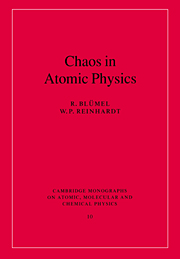Book contents
- Frontmatter
- Contents
- Preface
- 1 Introduction
- 2 Chaos: tools and concepts
- 3 Chaos in classical mechanics
- 4 Chaos in quantum mechanics
- 5 The kicked rotor: paradigm of chaos
- 6 Microwave-driven surface state electrons
- 7 The hydrogen atom in a strong microwave field
- 8 The kicked hydrogen atom
- 9 Chaotic scattering with CsI molecules
- 10 The helium atom
- 11 Chaos in atomic physics: state of the art and research directions
- References
- Index
10 - The helium atom
Published online by Cambridge University Press: 14 September 2009
- Frontmatter
- Contents
- Preface
- 1 Introduction
- 2 Chaos: tools and concepts
- 3 Chaos in classical mechanics
- 4 Chaos in quantum mechanics
- 5 The kicked rotor: paradigm of chaos
- 6 Microwave-driven surface state electrons
- 7 The hydrogen atom in a strong microwave field
- 8 The kicked hydrogen atom
- 9 Chaotic scattering with CsI molecules
- 10 The helium atom
- 11 Chaos in atomic physics: state of the art and research directions
- References
- Index
Summary
The stability of the solar system is one of the most important unsettled questions of classical mechanics. Even a simplified version of the solar system, the three-body problem, presents a formidable challenge. An important breakthrough occurred when Poincaré, with some assistance from his Swedish colleague Fragmen, proved in 1892 that, apart from some notable exceptions, the three-body problem does not possess a complete set of integrals of the motion. Thus, in modern parlance, the three-body problem is chaotic.
The helium atom is an atomic physics example of a three-body problem. On the basis of Poincaré's result we have to expect that the helium atom is classically chaotic. Richter and Wintgen (1990b) showed that this is indeed the case: the helium atom exhibits a mixed phase space with intermingled regular and chaotic regions (see also Wintgen et al. (1993)). Thus, conceptually, the helium atom is a close relative of the double pendulum studied in Section 3.2. Given the classical chaoticity of the helium atom we are confronted with an important question: How does chaos manifest itself in the helium atom?
In order to provide clues for an answer to this question we study in this chapter a one-dimensional version of the helium atom, the “stretched helium atom” (Watanabe (1987), Blümel and Reinhardt (1992)). This model, although only a “caricature” of the three-dimensional helium atom, is realistic enough to capture some of the most important physical features of the helium atom.
Information
- Type
- Chapter
- Information
- Chaos in Atomic Physics , pp. 240 - 283Publisher: Cambridge University PressPrint publication year: 1997
